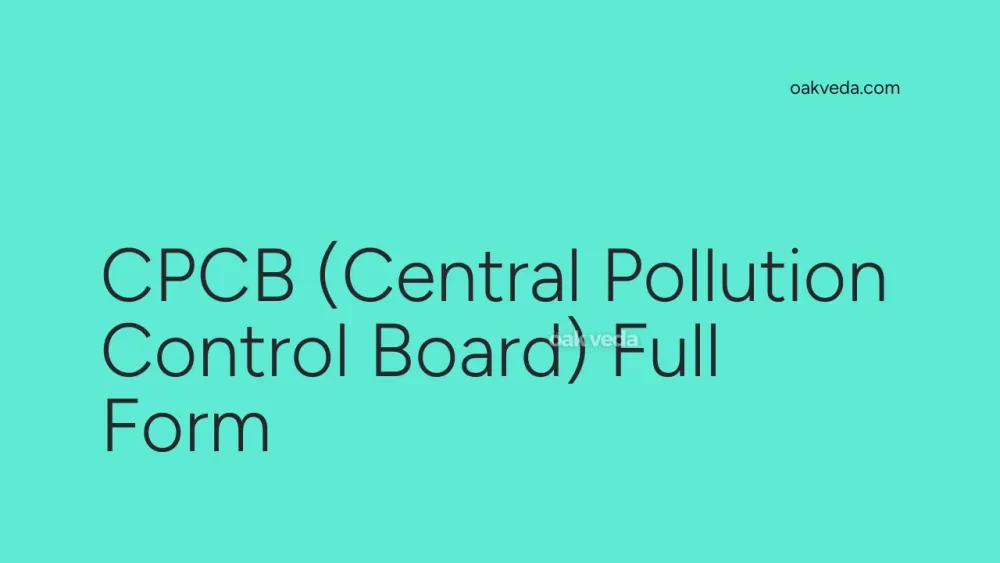
What is the Full Form of CPCB?
The full form of CPCB is Central Pollution Control Board. This statutory organization plays a crucial role in environmental protection and pollution control in India.
What is Central Pollution Control Board?
The Central Pollution Control Board (CPCB) is a premier government agency in India responsible for monitoring and controlling environmental pollution. Established under the Water (Prevention and Control of Pollution) Act of 1974, the CPCB has since become the cornerstone of India's efforts to combat various forms of pollution and protect its natural resources.
Origin and Development of Central Pollution Control Board
The CPCB was founded in September 1974, following the enactment of the Water Act. Its mandate was later expanded under the Air (Prevention and Control of Pollution) Act of 1981. This expansion of responsibilities reflects the growing awareness of environmental issues in India and the need for a comprehensive approach to pollution control.
Over the years, the CPCB has evolved to address emerging environmental challenges, adapting its strategies and technologies to meet the changing needs of India's rapidly developing economy and growing population.
How does Central Pollution Control Board work?
The CPCB operates under the aegis of the Ministry of Environment, Forest and Climate Change. It functions through a network of zonal offices, laboratories, and monitoring stations across India. The board is led by a chairman appointed by the Central Government.
The CPCB works in close collaboration with State Pollution Control Boards (SPCBs) and Pollution Control Committees (PCCs) in Union Territories. This cooperative approach ensures a coordinated effort in implementing pollution control measures throughout the country.
Functions of Central Pollution Control Board
The CPCB performs a wide range of functions to fulfill its mandate:
-
Air Quality Monitoring: The board operates the National Air Quality Monitoring Programme (NAMP) to assess and track air quality levels across India.
-
Water Quality Management: CPCB monitors water quality in rivers, lakes, and groundwater sources, implementing measures to prevent and control water pollution.
-
Industrial Pollution Control: It sets standards for industrial emissions and effluents, ensuring compliance through regular inspections and audits.
-
Waste Management: The board develops guidelines for proper handling and disposal of various types of waste, including municipal solid waste, biomedical waste, and e-waste.
-
Research and Development: CPCB conducts and promotes research on pollution control technologies and environmental conservation.
-
Public Awareness: It organizes campaigns and educational programs to raise awareness about environmental issues and pollution control.
-
Policy Advisory: The board advises the Central Government on matters related to pollution prevention and control.
Applications of Central Pollution Control Board
The work of the CPCB has far-reaching applications across various sectors:
- Urban Planning: CPCB's data and recommendations inform urban development strategies to create more sustainable cities.
- Industrial Development: Industries rely on CPCB guidelines to implement eco-friendly practices and comply with environmental regulations.
- Public Health: By monitoring and controlling pollution, the CPCB plays a crucial role in safeguarding public health.
- Environmental Conservation: The board's efforts contribute to the preservation of India's biodiversity and natural ecosystems.
Features of Central Pollution Control Board
Key features of the CPCB include:
- Statutory Authority: As a statutory body, the CPCB has legal powers to enforce environmental regulations.
- Technical Expertise: The board employs a team of scientists, engineers, and environmental experts.
- Comprehensive Approach: CPCB addresses multiple forms of pollution, including air, water, and soil contamination.
- Data-Driven Decision Making: The board relies on extensive monitoring and research to inform its policies and actions.
- Collaborative Framework: CPCB works in partnership with state-level bodies and other government agencies.
Benefits of Central Pollution Control Board
The existence and work of the CPCB offer numerous benefits:
- Improved environmental quality across India
- Enhanced public health through reduced pollution levels
- Promotion of sustainable industrial practices
- Increased awareness about environmental issues among the public
- Support for India's commitments to international environmental agreements
Limitations or Challenges of Central Pollution Control Board
Despite its crucial role, the CPCB faces several challenges:
- Resource Constraints: Limited manpower and financial resources can hinder the board's ability to monitor and enforce regulations effectively.
- Rapid Industrialization: The fast pace of industrial growth in India poses challenges in keeping up with new sources of pollution.
- Enforcement Issues: Ensuring compliance with environmental norms across a vast and diverse country remains a significant challenge.
- Technological Gaps: Keeping up with the latest pollution monitoring and control technologies requires continuous upgradation.
Future Developments in Central Pollution Control Board Technology
The CPCB is continuously evolving to meet future challenges:
- Advanced Monitoring Systems: Implementation of real-time, IoT-based pollution monitoring networks.
- AI and Big Data: Utilizing artificial intelligence and big data analytics for more accurate pollution forecasting and management.
- Green Technologies: Promoting and adopting cutting-edge green technologies for pollution control.
- Enhanced Public Engagement: Developing mobile apps and online platforms for greater public participation in environmental monitoring.
FAQs on CPCB Full Form
-
What is the primary objective of CPCB? The primary objective of CPCB is to promote cleanliness of streams and wells, and improve air quality by preventing, controlling, and abating water and air pollution in India.
-
How does CPCB monitor air quality? CPCB operates the National Air Quality Monitoring Programme (NAMP), which includes a network of monitoring stations across India that measure various pollutants like PM10, PM2.5, SO2, NO2, and others.
-
Can the public access CPCB's pollution data? Yes, CPCB provides public access to air and water quality data through its website and mobile applications.
-
How does CPCB contribute to industrial pollution control? CPCB sets emission and effluent standards for industries, conducts inspections, and provides guidelines for pollution control technologies.
-
What is the relationship between CPCB and State Pollution Control Boards? CPCB coordinates the activities of State Pollution Control Boards, provides technical assistance, and resolves disputes between them when necessary.
You may be interested in:

